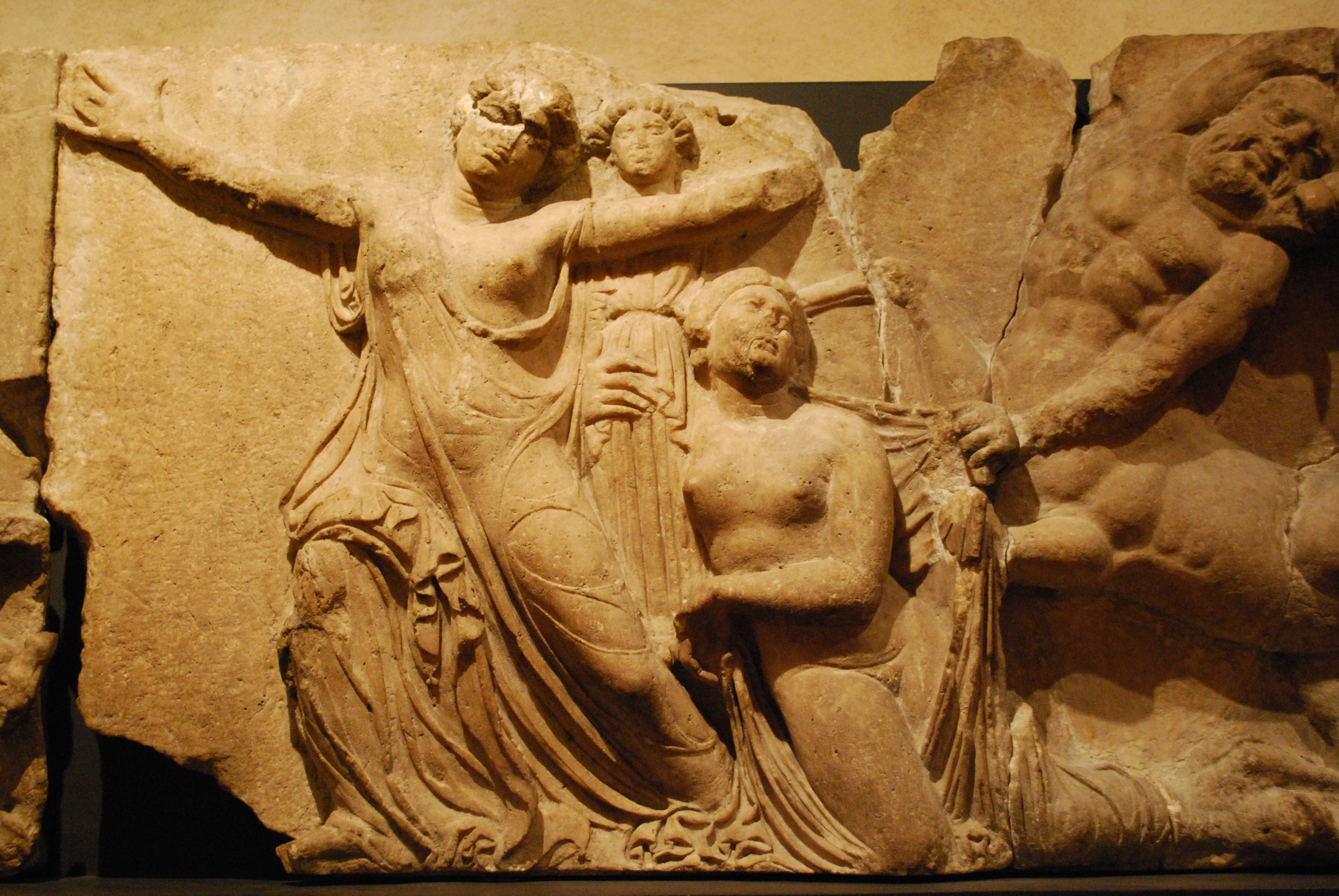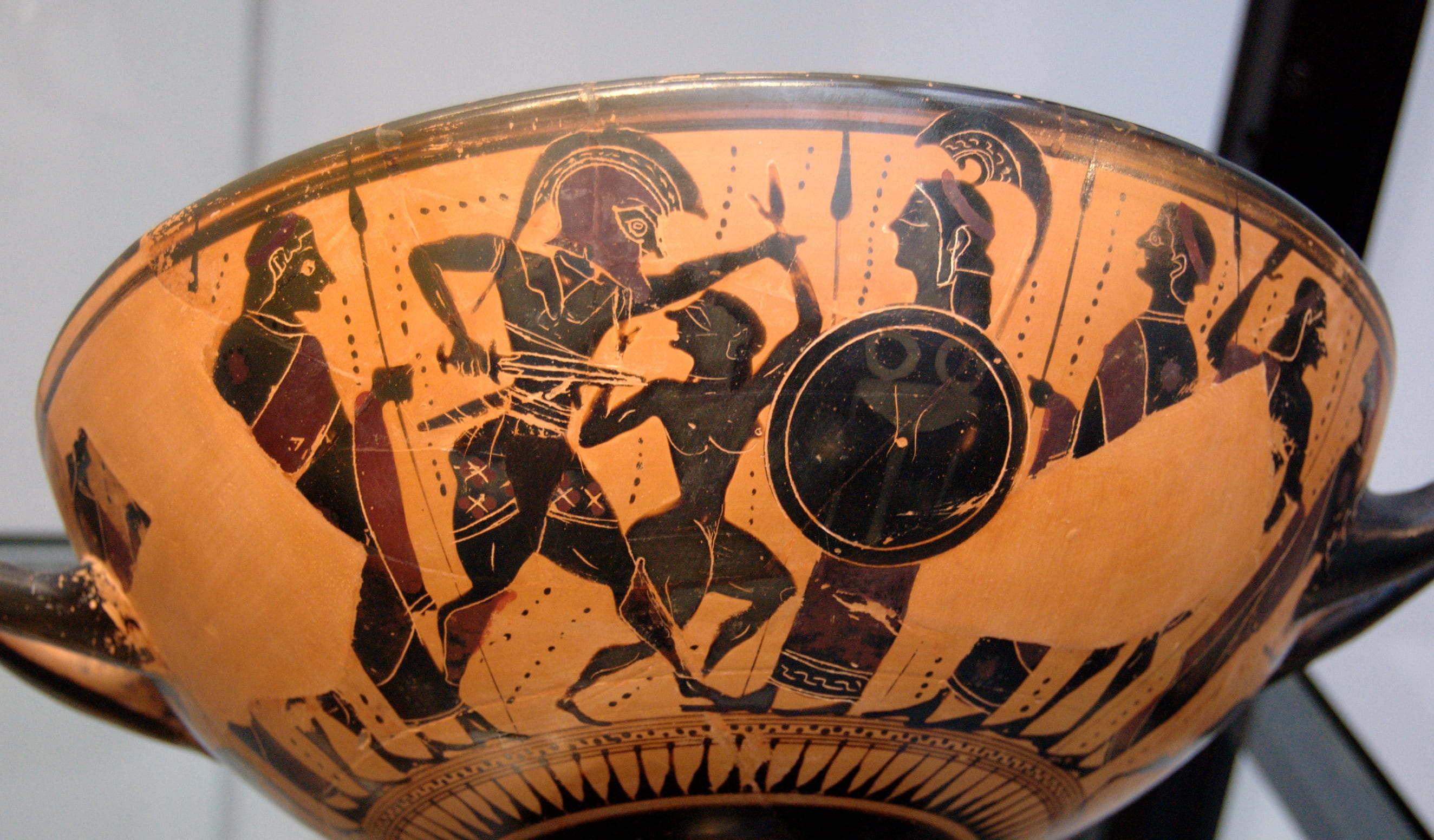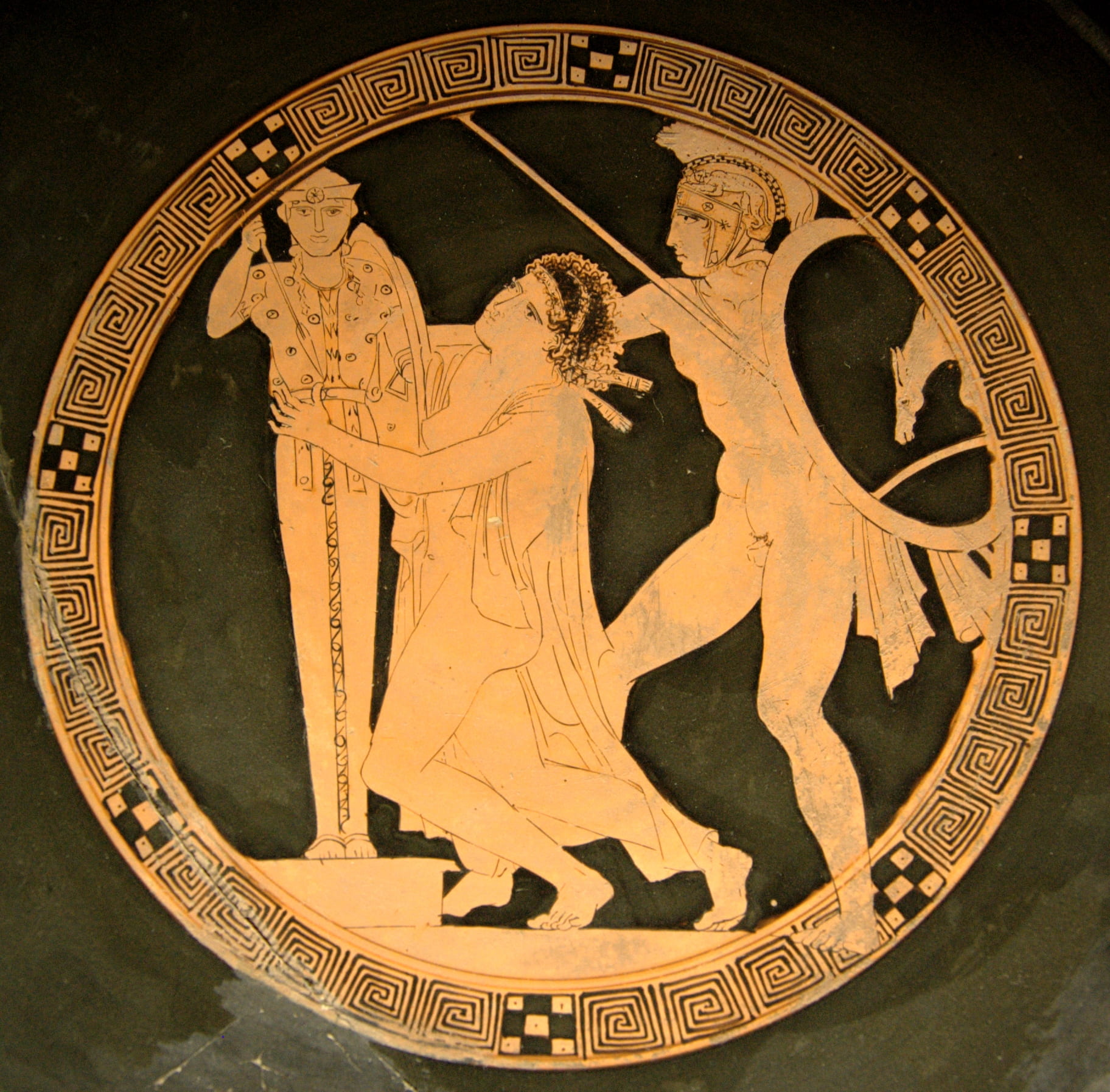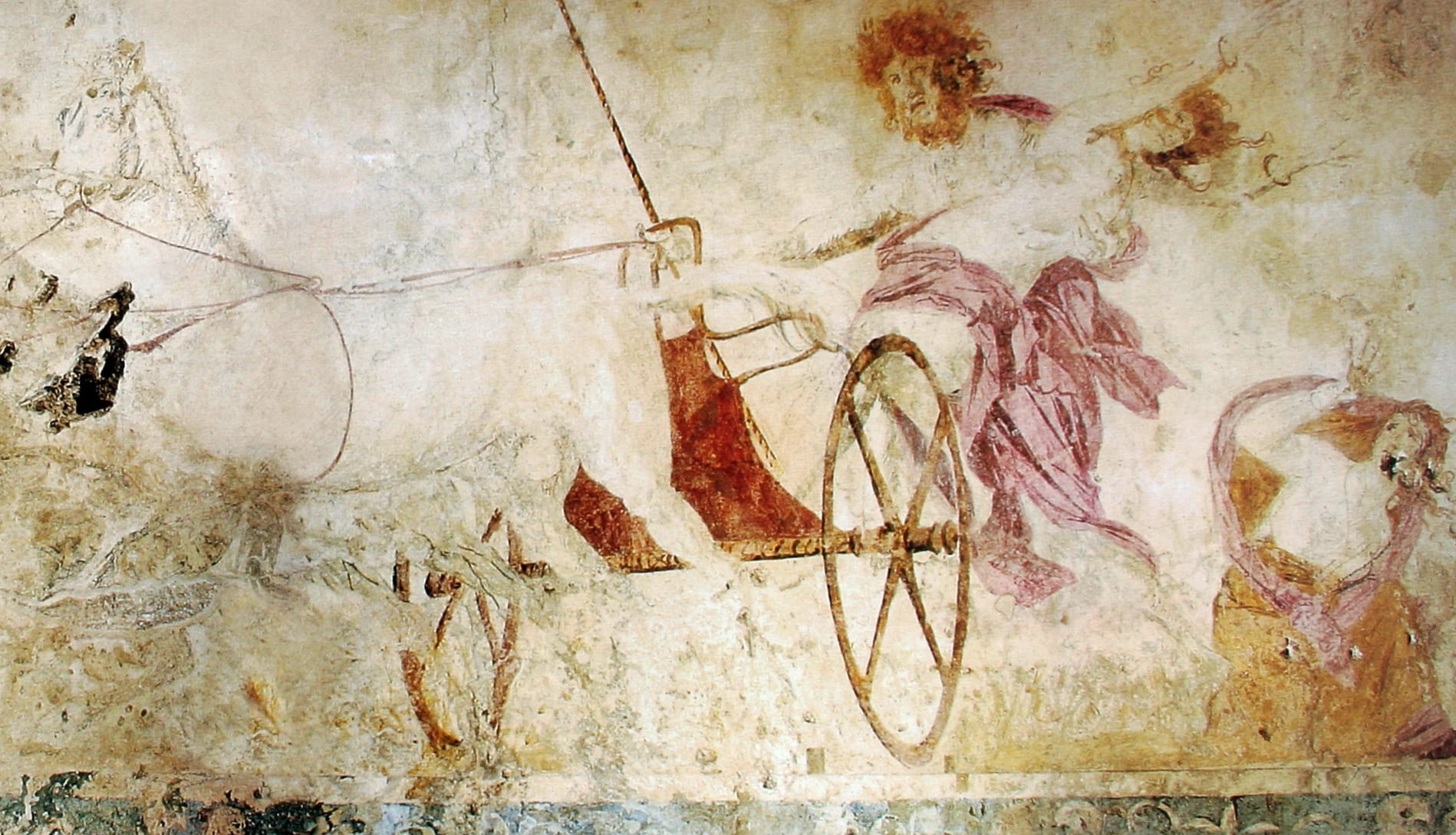By Contributing Writer Rebecca Levitan
When I began studying ancient Greek art as an undergraduate student, I was initially disturbed by the detailed depictions of violence against women. I was also confused that some of the most graphic of these images occurred in the art of the Classical period, which had been introduced to me as the apogee of democracy and reason. Yet, satyrs on vases grasped at fleeing maenads (in the new technology of red figure!). A temple dedicated to a god who had saved the local population from plague was adorned with images of both men on horseback and centaurs attacking women, some of whom clung to cult statues, praying (unsuccessfully) for sanctuary from violation (Figure 1). The shield of the statue of Athena Parthenos, a female deity and the patron goddess of democratic Athens, was similarly decorated with violent scenes of heroic Greek men attacking female figures.

Figure 1: Two women have sought sanctuary at the temple. The woman on the left supplicates to the goddess for safety, while the other – on the right – clings to a wooden cult statue. Their pleas, however, are ignored, by the attacking centaur. Scene from the frieze of the temple of Apollo at Bassae, late 5th century B.C.
My freshman art historical anxieties were quickly quelled by some iconographical clarification. As my professor explained:
Yes, we do sometimes call these images where women are grabbed or carried off by strange men and hybrid monsters “rapes,” but this is a quirk of translation, coming from the Latin/Italian rapere/rapina, which means “seizure” or “robbery.”
My eighteen-year-old brain did not think to ask what the terms for “rape” would be, which, of course, are also rapere/rapina.
The explanation continued:
Those women being speared and trampled on in the 101 lecture slides? They aren’t normal women, but mythological Amazons. See how their dress is different than the upright maidens of the Erechtheion–how they wear short costumes and ride horses themselves? These aren’t real ladies.
Subtext: They are as abstract as the [female] sphinxes and sirens and gorgons that Greek heroes had every right to cut down.
My professor also explained that depictions of violence against Persians, Giants, Amazons, and Centaurs were probably understood in much the same way for an ancient Greek viewer, despite the fact that some of these opponents were mythological while others were inspired by real life enemies of the Greeks (see the metopes of the Parthenon for an example). Modes of classification within the field of Classical Art History have maintained this ancient outlook.
And thus, I learned to label all sorts of attacks within the broader lexicon of Greek violence. Just as the battles of the Olympian gods against the Titans became the “Gigantomachy,” the aggression of heroic nude Greek men against these short-skirted women became “Amazonomachy.” Without a knowledge or vocabulary of “othering,” my freshman-self found this distancing terminology all very comforting. The same went for scenes of individual women being seized. I even remember as an upperclassman confidently reassuring a younger student not to be alarmed by the presence of the word “rape” on a lecture handout. “It means something different here, just abduction.” I happily consumed this terminological Kool Aid well into my graduate studies in Greek and Roman art. I believe there are two reasons why.
The first is the complexity of classical visual narrative. When it comes to Greek iconography – and the larger visual tradition that it inspired – images are usually coded with secondary meanings. Once trained, we can read these attributes/signs and then piece together the ancient narrative, usually familiar from mythology or epic. The process of close looking, and associated terminology that we employ in this practice, prioritize zooming in – searching for the minuscule and then categorizing it. Learning this visual code is part of the reason that the study of these objects requires significant art historical training, and why the endeavor is worth it. To search for these clues and then recognize a scene can be very rewarding.
However, close looking can come at the expense of the bigger picture questions: what do these scenes signify, and why were they appealing to ancient viewers and consumers? We have built such a deliberate disciplinary focus on detail that the larger context of viewing in the ancient world is often neglected. An exception to this might be the viewing context of the Athenian symposium, or all male drinking party, which is well documented in both the literature (think Plato) and material evidence (lots of the painted pottery that survives from antiquity). But participation in the symposium was limited to a small, male, cross-section of society.
The second, related, impediment to a big-picture analysis of ancient images of violence comes from the fact that Greek imagery of rape does not directly depict the forced sex act itself. Instead, we are often shown the moments just before, when the victims – usually women but sometimes girls and boys – are seized unwillingly. Explicit depictions of penetration do occur in Greek Art, but are usually reserved for other (non-mythological) contexts, such as depictions of sex which occurred in the sphere of the aforementioned symposium, or in grotesque scenes of satyrs.
Some have interpreted this as evidence that ancient authors and artists did not have a concept of rape and therefore the term abduction is more appropriate. I beg to differ. Who actually believes that grabbing and carrying off is where things end? We only need to look so far as the Homeric heroes, the good guys, and their treatment of captive figures like Briseis and Cassandra for a not-so-good clue (Figures 2 and 3).

Figure 2: Homeric hero Ajax the Lesser and Trojan Princess Cassandra (central figures), in front of the Palladion (cult statue of Athena), 6th century B.C.

Figure 3: Another scene of Ajax and Cassandra, painted about a century later than Fig 2, and in the red figure technique. Although the violence and nudity is less graphic, the coded meaning is the same.
Many classicists, archaeologists, and art historians have also been happy to accept the caprice of rapes that involve trickery as somehow being something more palatable. As classicist Mary Lefkowitz has written
In the case of myths involving the unions of gods and goddesses with mortal men and women, we should talk about abduction or seduction rather than rape, because the gods see to it that the experience, however transient, is pleasant for the mortals. Moreover, the consequences of these unions are usually glorious for the families of the mortals involved, despite and even because of the suffering that the individual members of the family may undergo. (17)
Those teaching the visual representations of such scenes seem to be in agreement. If there isn’t a fitting term for the events when one of the participants is a swan, or a shower or gold, or a bull, or an eagle, then it’s just an embrace or a visit from Zeus… right? Perhaps part of the reason that many academics have accepted and employed alternative terms such as abduction or seduction instead of rape is that the alternative experience for the scholar is pretty unsavory. A literal description of the events underlines the fact that these are not images made for equal enjoyment by all ancient viewers. An explicit label of rape in the classroom would demand that we confront the inherent violence, misogyny, and alarming nature of these images, an act that may be triggering both for students and instructors.
I recently listened to a report by a scholar at an archaeological site in which the presenter explained that the Greeks were capable of portraying consent (or lack thereof) in their art, a helpful first step in moving away from the seduction paradigm. He cited the spectacular painting from a Macedonian tomb, where Persephone looks absolutely terrified and resists Hades as he drags her down into the underworld (Figure 4). The presenter was absolutely right to point out that this is not an image of healthy consent. But he also neglected to mention that the visible lack thereof was probably part of the larger appeal of the scene for male viewers: it was a turn on. The erotic aspect of Persephone’s resistance was resonant nineteen centuries later, when the scene was taken up by Bernini in Rome, creating perhaps the most compelling passage in marble ever carved. The same phenomenon of visual consumption seems to have persisted even into the notoriously stuffy Victorian period, when classicism served as a guise and pretext for the consumption of texts and display of images that would never otherwise have been acceptable, as evidenced by the popularity of sculptures like Hiram Powers Greek Slave or paintings like Solomon J. Solomon’s Ajax and Cassandra.

Figure 4: A wall painting from a Hellenistic tomb depicting the ‘Rape/Abduction of Persephone’: Hades, a mature god (center right), forcibly captures Persephone, a maiden goddess. Although she resists, he has dragged her onto her his chariot, which races down to the Underworld, where she will become his wife. Her mother, the goddess Demeter (rightmost), looks on in horror. Vergina, 4th century B.C.
I am not advocating that we avoid teaching with the images because they are uncomfortable. Even without the rosy glow of the minimizing terminology of abduction, I still think these are important works of art, deserving of study and contextualization in their own time. But rather, I hope that as instructors we can only agree to teach them if we are prepared to confront what is really happening and reflect on what that says about ancient viewers and ourselves. Moralizing won’t do much to change the reality of the situation. As a survey of some mainstream contemporary porn websites or the popularity of television shows like Game of Thrones can attest, the ancient people commissioning, making, and enjoying this ancient media weren’t so different from us. Depictions of sex and violence created for entertainment’s sake still sell, and the fascination they provoke is likely simply part of the human condition. However, the nature of representations of sexual violence, along with the context in which they are viewed and the words used to describe them, are mirrors that reflect the viewers and patrons of this type of imagery and the societies that they inhabit.
In the meantime, as scholars and educators, we can at least take a tiny step to correct the linguistic distancing so common in our teaching: let’s be explicit in the terminology we use to describe these scenes and explain to our students and readers why. Yes, these figures in Greek art are mythological and can be categorized; they are Lapiths, and Amazons, and war captives, and Nymphs. But they are also women and young men being raped, the action is simply shown using an implicit visual alphabet. These are not rapes because of some quirk of transliteration, nor are they abductions. These are coded representations of the act that we have been sidestepping and ignoring. Sugarcoating what we see in Greek Art or hiding behind arcane terminology does no favors to those who are interested in history, classical material culture, or sexuality.
Furthermore, let’s be honest about the context of these images. They were ubiquitous enough to appear in both sacred and profane contexts, in the home and in public, and in objects used by the living and dedicated to the dead. Perhaps more uncomfortably, the images were likely so popular because of their ability to titillate and excite the typical ancient audience for art – namely male viewers. And the consumption of these types of images did not end with the ancients. Rather, the perceived authority and purity associated with the Classical world allowed for their perpetuation throughout the history of Western Art.
These images depict rapes in every sense of the word. To state this aloud may rub against modern sensibilities, yes, but it does not mean that these images are not beautifully rendered, or important. How instructors should deal with this fact in the age of #metoo and trigger warnings is debatable. But it’s truth is not.
Calling out the act we see so often in Greek art (without quotations or caveats) will inevitably change the set of conversations around the images, but this change is necessary and overdue, and I hope that scholars will embrace the discomfort that comes with an honest assessment of this genre of classical iconography. After all, language choices make a difference in our own learning, published scholarship and teaching. The effects of these choices may be lingering, not only in our own work, but the way our students process images, as I hope my own experience as an undergraduate student illustrates.
Enough with abductions. In our teaching and in our scholarship, let’s call a spade a spade and a rape a rape.
With many thanks to M. Glennon, J. Stager, and D. O’Leary for their comments and insights.
Rebecca Levitan is a PhD candidate in Art History. She has been studying the material culture of classical antiquity in the classroom, museum, and on site for about ten years. In 2018 she was the recipient of a graduate student teaching award from UC Berkeley.




May 7, 2019 at 11:56 am
Excellent read and eye-opening for me.
June 2, 2021 at 8:43 am
Dr. Levitan, this is an excellent article and I completely agree. I was able to spend some time in Greece with this incredible wall painting of the Abduction of Persephone from the Tomb of Phillip II. As incredible as it looks in the photograph, it is stunning in person as I am sure you know. But I think you have made a small error in your captioning. The figure in the right hand corner is not Demeter, it is Persephone’s friend and companion with whom she is picking flowers. This photo does not show the adjacent panel which is of Demeter weeping. Recognizing the companion I think strengthens your analysis of this work. Persephone is completely surprised by the appearance of Hades and the violence of the act is heightened by the reaction of the friend.
June 2, 2021 at 11:25 pm
Yes there were rapes and abductions and they were depicted in ancient Greek literature. They reflect the mindsets of people who lived then, especially the mind sets of males. In the Greek tragedies that we have, many depict women as dangerous and duplicitous. That was a common attitude towards women. I think the Ancient Greeks didn’t invent misogyny, but they expressed it in a way that influenced subsequent generations profoundly.